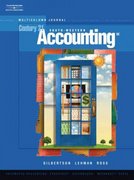Question
File attached. Directions below: Kelly's Boutique is contemplating several means of financing their acquisition of $100,000 in special equipment. One alternative is to borrow $100,000
File attached. Directions below: Kelly's Boutique is contemplating several means of financing their acquisition of $100,000 in special equipment. One alternative is to borrow $100,000 from a local bank for 10 years at 12 percent per annum. The bank has asked them to produce a 1-year cash budget broken down by months (January through December). Sales of $30,000 are expected in the first month, with each month thereafter increasing 2 percent. Purchases are based on an expected cost of sales of 55 percent and a required ending inventory of 70 percent of next month's cost of sales. Beginning inventory was $11,000. Sales for January next year are expected to be $40,000. Sales in the previous November and December were $29,000 and $28,000, respectively. Expenses include advertising expense of $900, depreciation expense of $800, interest expense of $1,000, payroll expense of $8,000, supplies expense of $500, and utilities expense of $600 per month throughout the year. All expenses except depreciation are paid in the month during which they are incurred. Collections in the month of sale are expected to be 50 percent, collections in the first month following a sale 40 percent, and in the second month 10 percent. Payments in the month of purchase are expected to be 75 percent, payments in the first month following a purchase 15 percent, and payments in the second month to 154 155 be 10 percent. Purchases in the previous November and December were $16,000 and $17,000, respectively. Proceeds from the $100,000 loan are expected in June, and $100,000 of equipment will be purchased in July. Monthly payments of $1,400 on the loan also begin in July. The beginning cash balance in January was $22,000. Using the ch6-04 file to start your work, create a cash budget (as you did in the chapter) that is based on the assumptions listed in the previous paragraph. Use Excel's grouping feature to group operating cash receipts, operating cash payment, cash from (to) operating activities, cash from (to) investing activities, and cash from (to) financing activities and also to group the twelve monthly columns together. Save your file as ch6-04_student_name (replacing student_name with your name). a. Print the newly completed worksheet in Value view, with your name and date printed in the lower left footer and the file name in the lower right footer. b. Print the worksheet from part a, above, in Formula view, with your name and date printed in the lower left footer and the file name in the lower right footer. Print only columns A and B of the cash budget, no assumptions. c. Collapse rows to level 2 and columns to level 1, and then print the worksheet in Value view with your name and date printed in the lower left footer and the file name in the lower right footer. Print cash budget only, no assumptions. d. Collapse rows to level 2 and columns to level 1, and then use what-if analysis to calculate end-of-year cash if the sales growth each month were 5 percent and payroll expense were $20,000 per month. Print the resulting worksheet in Value view, with your name and date printed in the lower left footer and the file name in the lower right footer. Print cash budget only, no assumptions. e. Undo the what-if analysis performed in part d. Collapse rows to level 2 and columns to level 1, and then use goal seek to determine what sales growth would be needed to produce an ending cash balance of $100,000. Print the resulting worksheet in Value view with your name and date printed in the lower left footer and the file name in the lower right footer. Print cash budget only, no assumptions. Check figures: All figures are for the YEAR: Operating cash receipts: $396,955 Cash payments for purchase: $224,121 Ending Cash: $54,434
Step by Step Solution
There are 3 Steps involved in it
Step: 1

Get Instant Access to Expert-Tailored Solutions
See step-by-step solutions with expert insights and AI powered tools for academic success
Step: 2

Step: 3

Ace Your Homework with AI
Get the answers you need in no time with our AI-driven, step-by-step assistance
Get Started


